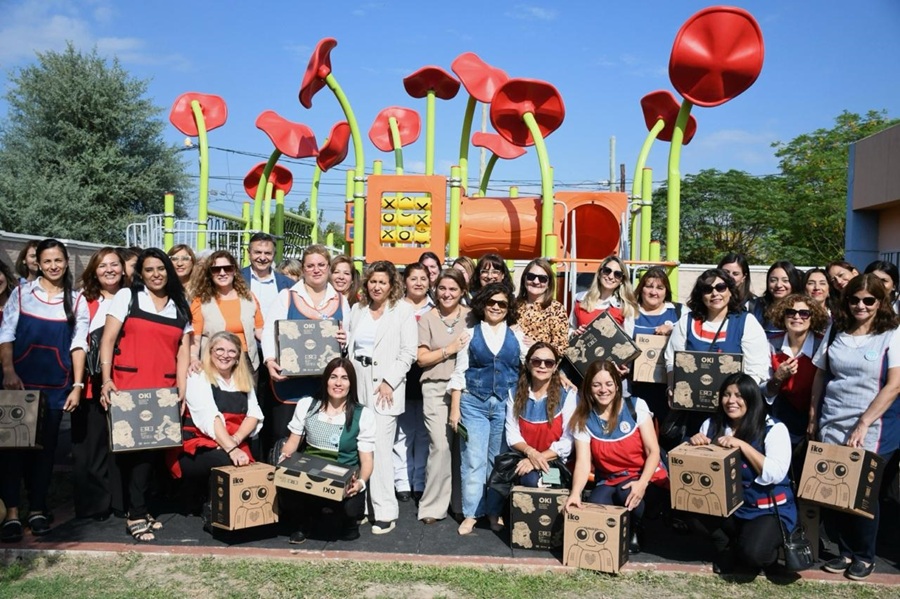El pontífice recibió a Fernández en una reunión privada en la Biblioteca Privada del segundo piso del Palacio Apostólico, precisaron fuentes vaticanas a Télam.
La reunión entre ambos fue la primera desde que Fernández dejó de ser presidente de Argentina el 10 de diciembre y se instaló en España, donde pasó Fin de Año.
Durante su mandato, de 2019 a 2023, Fernández visitó al Papa dos veces: una en enero de 2020 en el Palacio Apostólico y otra en mayo de 2021, en un salón del Aula Pablo VI.
Fernández destacó que, durante la reunión, pudo «agradecerle» al Papa «todo lo que ayudó y ayuda a la Argentina».
«Tuve la dicha de poder escuchar una vez más con humildad sus valiosas reflexiones sobre el presente de nuestro mundo», contó desde sus redes sociales.
Añadió que estuvo acompañado por su hijo, Francisco, a quien el Papa «bendijo con amor», y señaló que su pareja, Fabiola Yañez, «no pudo viajar porque el sábado fue intervenida quirúrgicamente por una apendicitis».
«Me transmitió para ella sus deseos de una pronta recuperación», destacó Fernández.
El Sumo Pontífice había planteado este domingo que analiza un posible viaje a Argentina para la segunda mitad del año, después de una visita que debe hacer en agosto a Papúa Nueva Guinea.
De concretarse, esa incursión en el país sería la primera desde que Jorge Mario Bergoglio fue entronizado como el Papa número 266 de la Iglesia, en marzo de 2013.
La reunión de este lunes se dio también a menos de un mes de la canonización que hará Francisco de la beata Mama Antula, el 11 de febrero, en la Basílica de San Pedro, lo que convertirá a esa religiosa en la primera santa argentina.
La canciller Diana Mondino transmitió la semana pasada a la Embajada vaticana en Argentina que el presidente Javier Milei tiene la «intención» de participar de la canonización que se hará a las 9.30 hora local (5.30 de Argentina).
Además, la Presidencia de Milei cursó la semana pasada una invitación formal al Papa para que regrese de visita a su país natal.





Your practical approach to this topic is refreshing compared to other theoretical articles out there.
Получить КОНСУЛЬТАЦИЮ и ПОДДЕРЖКУ профессиональных психологов. Психолог оказывает помощь онлайн в чате. Получите консультацию онлайн-психолога в чате прямо сейчас. оценили 1700 раз
I’ve just started a blog myself and your content strategy is truly inspiring.
Для створення затишної атмосфери та догляду за рослинами вдома чудово підійдуть стильні горщики для квітів та лійки. Вони поєднують функціональність із естетикою.
I’m sharing this with all my colleagues. Essential knowledge for our industry.
Contextual Insights Driving Online Casino Performance
The Role of Contextual Insights in Online Casino Success
In a sector where competition intensifies daily, understanding
the nuanced factors influencing player engagement is paramount.
An analysis of player behavior and preferences reveals key aspects that can enhance
revenue and retention strategies. For instance, introducing personalized experiences
based on player data can significantly boost user loyalty and interaction time.
Data from recent industry reports highlights that over 70% of players prefer
platforms that offer tailored rewards and promotions.
This demographic insight serves as a critical pathway for operators
aiming to optimize marketing efforts. Implementing systems that gather real-time
data on player activity allows for a more nuanced approach to user experience, turning
casual users into dedicated patrons.
Additionally, examining regional trends uncovers varying preferences, with mobile usage
often surpassing desktop engagement in certain markets. Prioritizing mobile-friendly
designs and features that cater to on-the-go players can lead to an increase in daily active users.
By aligning platform capabilities with user expectations, operators can capitalize
on shifting engagement patterns to ensure sustainable growth.
Identifying Market Trends Impacting Player Engagement in Gaming Platforms
Monitoring player behavior reveals several key trends influencing participation levels.
One significant observation is the increasing demand for personalized
experiences. Data indicates that tailored content enhances
user satisfaction, leading to a notable increase in playtime and retention rates.
Operators should implement advanced analytics to gather insights into individual player habits and preferences.
The rise of mobile gaming is another factor reshaping player interaction.
Statistics show that over 70% of gamers access platforms via smartphones.
This shift necessitates an optimization focus on mobile interfaces and functionality, ensuring seamless navigation and responsive designs.
Enhancing mobile experiences can significantly boost engagement
metrics.
Social gaming features are gaining traction among users
who value community and interaction. Research indicates that platforms offering social
elements, such as leaderboards and chat functions, retain users at higher rates.
Integrating gamification strategies can provide a competitive edge, as friendly competition encourages longer sessions.
Furthermore, the impact of emerging technologies cannot be overstated.
Virtual reality (VR) and augmented reality (AR) applications are
being explored to create immersive experiences.
Early adopters of these technologies report enhanced player
involvement and a distinct differentiation from competitors.
Investing in VR/AR capabilities could attract a
new audience segment.
Lastly, regulatory changes and responsible gaming initiatives are shaping player expectations.
Transparent practices and adherence to legal requirements improve trust
and foster loyalty. Establishing user-friendly tools for setting limits on play can enhance player relationships
and align with industry standards.
Utilizing Data Analytics to Optimize Game Offerings and User Experience
Harnessing the potential of data analytics allows operators to
refine their game selections and enhance player interactions.
By examining player behavior patterns, businesses can identify
which games engage users most effectively and which
tend to fall flat. This data-driven approach ensures that offerings resonate with the preferences and habits of the target audience.
Analyzing metrics such as time spent on each game, session frequency,
and return-to-player (RTP) rates can indicate which titles
are performing well. For instance, games that attract prolonged play sessions and high player retention may suggest a need for promotion or additional content updates.
Using A/B testing, operators can experiment with variations in game features, bonus structures, and graphics to gauge player responses.
Additionally, understanding user demographics and preferences
is crucial. Analyzing data related to age, geographical location, and gaming habits
helps in tailoring the game portfolio to meet specific audience demands.
By segmenting users and customizing promotions based on their profiles, engagement rates can significantly increase.
Player feedback, collected through surveys and on-site interactions, provides qualitative insights that complement quantitative data.
Combining these two sources separates high-performing titles from
those requiring adjustments. This practice not only enriches the
gaming catalog but also cultivates a community-oriented
atmosphere, driving loyalty.
Integrating artificial intelligence can further enhance data analysis, enabling real-time adjustments to game offerings based on current trends and player activity.
Predictive analytics models help in forecasting player behavior, allowing businesses to stay one step ahead by anticipating
player needs and preferences.
In offering a diversified range of games, pairing traditional slots with innovative variations can tap into different player segments.
Understanding competitive dynamics through market analysis empowers operators to make informed decisions
on game acquisition and development, ensuring that they stay relevant in a crowded marketplace.
my webpage … aviator app
Колпаки с наклонной крышкой лучше отводят воду.
https://myhousingwiki.com/index.php/Kolpak_100H